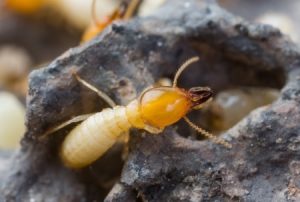
Because termites are so stealth and an infestation can get out of control before anyone knows there is even a problem, the best way to avoid termites in your home is to take preventative measures. While it is possible to treat and eradicate a termite infestation, getting ahead of the curve is challenging and expensive. Preventing them from ever getting into your home is the best route.
In order to prevent an infestation, you need to know what to look for. Below are some definitive signs of termite damage that you can look for around your home:
Wood that sounds hollow when you knock on it. Termites like to eat wood from the inside out. They will burrow into a piece of wood at one entry point and then stay inside of that piece of wood digging holes and tunnels. They prefer dark, humid environments so wood that is damp and rotting is an ideal location for a termite colony to nest.
Wing fragments. Certain members of a termite colony are able to grow wings so that they can fly to other locations and reproduce to establish new colonies. Once the new location has been established, these termites lose their wings and the fragments fall to the ground.
Mud cones/tubes. Termites prefer living in a moist environment. Once a colony is established they will build tubes or cones made from mud to capture moisture and keep the colony environment to their liking.
April is the height of termite activity. During the cold weather they are very dormant, reserving energy and resources. However, once the weather warms up it is time to start looking for new locations for their colonies. Don’t let your home or garage be their new home – check around your property once per month throughout the spring and summer for these signs of termite activity.
